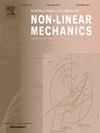GH4033高温合金现象学本构方程与物理本构方程的比较
IF 3.2
3区 工程技术
Q2 MECHANICS
International Journal of Non-Linear Mechanics
Pub Date : 2025-05-24
DOI:10.1016/j.ijnonlinmec.2025.105172
引用次数: 0
摘要
建立了预测GH4033高温合金热流应力的现象学和物理本构方程,并进行了比较。在变形温度为950、1050、1150和1200℃,应变速率为0.001、0.01、0.1、1和10 s−1的条件下进行等温单轴压缩试验。基于流动应力-应变曲线数据,建立了现象学本构方程(修正Johnson-Cook模型、arrhenius型模型)和物理本构方程(修正zerili - armstrong模型、微结构本构模型)。进一步对修正后的Johnson-Cook模型和基于微观结构的模型进行了修正,以提高预测精度。通过确定系数和平均绝对相对误差对所提出的本构方程的预测精度进行了评价,修正Johnson-Cook模型的预测精度分别为0.9680和14.05%,应变补偿arrhenius型模型的预测精度分别为0.9773和9.58%,修正zerill - armstrong模型的预测精度分别为0.9961和6.53%,基于微观结构的模型的预测精度分别为0.9948和4.53%。结果表明,所建立的物理本构方程能够准确预测GH4033高温合金的热流应力行为。本文章由计算机程序翻译,如有差异,请以英文原文为准。
Comparison of the phenomenological and physically-based constitutive material equations for GH4033 superalloy
Phenomenological and physically-based constitutive equations for predicting the hot flow stress of the GH4033 superalloy were developed and compared. Isothermal uniaxial compression tests were conducted in the deformation temperatures of 950, 1050, 1150 and 1200 °C, and strain rates of 0.001, 0.01, 0.1, 1, and 10 s−1. Based on the flow stress-strain curves data, phenomenological constitutive equations (modified Johnson-Cook model, Arrhenius-type model) and physically-based constitutive equations (modified Zerilli-Armstrong model, microstructural based model) were developed. The modified Johnson-Cook model and microstructural based model were further modified to enhance the prediction accuracy. The prediction accuracy of the proposed constitutive equations was appraised by the determination coefficient and the average absolute relative error, which are 0.9680 and 14.05 % for the modified Johnson-Cook model, 0.9773 and 9.58 % for the strain compensated Arrhenius-type model, 0.9961 and 6.53 % for the modified Zerilli-Armstrong model and 0.9948 and 4.53 % for the microstructural based model, respectively. The result shows that the proposed physically-based constitutive equations are very suitable for accurately predicting the hot flow stress behavior of GH4033 superalloy.
求助全文
通过发布文献求助,成功后即可免费获取论文全文。
去求助
来源期刊
CiteScore
5.50
自引率
9.40%
发文量
192
审稿时长
67 days
期刊介绍:
The International Journal of Non-Linear Mechanics provides a specific medium for dissemination of high-quality research results in the various areas of theoretical, applied, and experimental mechanics of solids, fluids, structures, and systems where the phenomena are inherently non-linear.
The journal brings together original results in non-linear problems in elasticity, plasticity, dynamics, vibrations, wave-propagation, rheology, fluid-structure interaction systems, stability, biomechanics, micro- and nano-structures, materials, metamaterials, and in other diverse areas.
Papers may be analytical, computational or experimental in nature. Treatments of non-linear differential equations wherein solutions and properties of solutions are emphasized but physical aspects are not adequately relevant, will not be considered for possible publication. Both deterministic and stochastic approaches are fostered. Contributions pertaining to both established and emerging fields are encouraged.

 求助内容:
求助内容: 应助结果提醒方式:
应助结果提醒方式:


